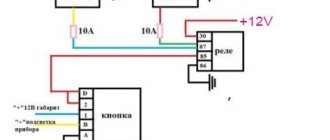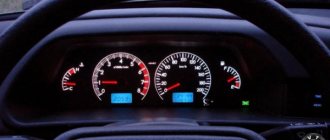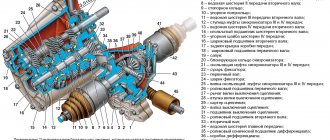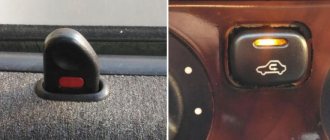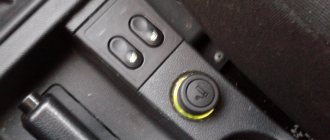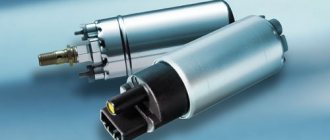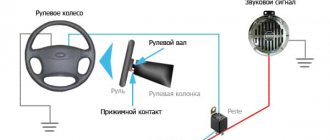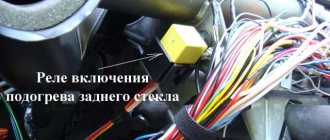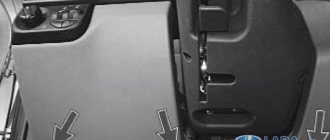Traffic regulations prescribe a special method of warning about maneuvers, which must be used if the turn signal lamps stop lighting on the road. Let's look at why turn signals don't work and how to eliminate the cause of the breakdown. We will talk about the design, operating principle and malfunctions of systems using turn signal relays based on integrated circuits. We will not consider old designs with bimetallic plates, as well as completely electronic systems, due to their specificity and low prevalence.
If only the front left or rear right turn signal on a car does not light up, the reason may be a burnt out light bulb, poor ground contact of the lights or a section of wire to the light bulb.
Causes of direction indicator malfunctions
- The fuse has blown. If the hazard warning lights stop working along with the turn signals, there is a high probability that the reason is the fuse link.
Instead of a blown fuse, install only an insert of the appropriate rating. Exceeding the recommended value and installing “bugs” can lead to a car fire. Therefore, we advise you to follow the rules for replacing fuses!
- Failure of the steering column switch.
- Damage to the turn signal relay.
- The hazard warning button is faulty.
- Open circuit. If the turn signals do not work on all sides, the first thing to check is the turn signal relay power wires. If the indicators stop working on only one side, the problem is in the wires running from the steering column switch to the light bulbs.
- Oxidized contacts, broken wires. The turn signals do not work if the circuit resistance differs significantly from the nominal value. To supply power, it is necessary to exceed a certain power level of consumers. If the microcircuit inside the turn signal relay does not register sufficient current due to increased resistance, power will not be supplied to the bulbs.
Device
The following are involved in the operation of turn signals:
- steering column turn switch. Its function is to close the power contact of the light bulbs. For example, when you turn the switch up, one of the contacts of the light bulbs on the right side closes to the “+” of the battery. The “minus” of the light bulb is the connection point to “ground” (the common point for all headlight bulbs);
- turn signal relay. There is a regular electromagnetic relay inside the case, but it is controlled by a microcircuit. It is thanks to this element that an intermittent power supply to the coil is ensured. The second important function is monitoring the health of the lamps. The microcircuit has a feedback function, so when a light bulb burns out, it registers a decrease in the power of consumers and begins to supply power to the coil at double the frequency. If the turn signals are working properly, the lights blink approximately once per second. Most modern cars, including VAZ models, use a 3-pin turn signal relay. Accordingly, 1 contact is “ground”, 2 – power supply from the battery, 3 – output to the steering column switch;
- light indication on the dashboard. One or two light bulbs (one on each side) are connected in parallel to the electrical circuit of the main lamps. The turn signals will work without a light indication, so the system should not be considered among the possible causes of the malfunction.
Connection diagram
The simplest turn signal connection diagram.
The video discusses in detail the principle of turning on the direction indicators, as well as the role of the hazard warning button in the operation of the system.
Replacing turn signal and hazard warning relays (+ Video)
After detecting any of the listed malfunctions, the turn signal relay must be replaced. Depending on the modification (carburetor or injector), the location of the breaker relay may differ noticeably. Carburetor VAZ 2107 vehicles require installation of the relay behind the dashboard in the vehicle interior. However, starting with an injection engine, the relay can be located in a mounting block in the engine compartment.
In order to remove the relay located in the mounting block, you just need to pry it up and pull it up. After this, a new element is installed in its place.
In the case of a relay located behind the panel, things are much more complicated. Before removing the relay, you must pry the dashboard using a screwdriver and remove it. If the length of the wires allows, you can pull it out a certain distance, but if they are too short, it is recommended to pull out the plugs and. Set the panel aside and disconnect the contact wires from the relay. Now unscrew the ground from the breaker and remove it. Install a new one in place of the old relay and insert the contact wires into it. After this, assemble the dashboard and install it in its original place. This completes the replacement of the turn signal relay.
That's all you need to know about the turn signal relay.
To install the emergency lights on a VAZ 2101 with our own hands, we need: an emergency light button from the six and a chip for it, a six-pin turn relay, a six-pin chip for the turn relay.
Here is the diagram for turning on the VAZ 2101 turns:
1 – sidelights;2 – side direction indicators;3 – battery;4 – generator;5 – ignition switch;6 – fuse block; 7 – turn signal breaker relay; 8 – turn signal indicator lamp; 9 – turn signal switch; 10 – rear lights
And this is the diagram for turning on the turns and hazard warning lights of the VAZ-2106:
1 — sidelights; 2 — side direction indicators; 3 - battery; 4 - generator; 5 — ignition switch; 6 — main fuse block; 7 - additional fuse block; 8 — relay-interrupter for alarm and direction indicators; 9 - indicator lamp for direction indicators in the speedometer; 10 — alarm switch; 11 — rear lights; 12 - direction indicator switch in a three-lever switch.
And this is the wiring diagram for the VAZ-2106 turn signal relay (view of the contacts):
We make the connection in the following sequence:
1. Disconnect the old turn relay (barrel) and connect the blue wire to pin 3 of the new relay, this is the control on the panel.
2. Connect a piece of wire to the 4th terminal of the new relay; when attaching the new relay, screw it to ground.
3. Connect the white and black wire (sometimes purple) to the 2nd pin of the relay and to the 7th pin of the hazard warning button (the numbers on the button are written on the back).
4. Add the orange wire (ignition) and connect it to pin No. 2 of the button.
5. Connect pin 1 of the turn signal relay to pin No. 4 of the hazard warning button.
6. We supply constant power to pin 8 of the button, for example from the first fuse.
7. Connect pin 1 of the button to the blue wire in the tube chip.
8. Connect pin 3 of the button to the blue one with a black stripe in the tube chip.
There is another option.
Ready-made wiring for connecting an alarm system is sold on the market:
: Red - to white with a black stripe (or purple), this is the load. Yellow - to blue (this is the control). Blue - to orange (ignition). Brown with a red stripe is a permanent plus (for example, on the first fuse). White and brown with a white stripe to the tube chip (left and right turns).
We attach the turn relay in place of the old one, not forgetting about the masses. We cut a round hole for the hazard warning button (the hole for the washer pump is ideal, but not on all models). If you want to somehow transform your car, I advise you to do it yourself, it looks just super!
The VAZ 2114 turn relay is an electronic element installed in the mounting block, which is responsible for the formation and operation of an intermittent light signal when indicating a right or left turn signal. In addition, the product provides periodic and simultaneous blinking of turn signals in hazard warning mode.
Most devices are equipped with multiple contacts, which makes it possible to control a variety of electrical circuits. Products of the electromagnetic type have become most popular and widespread.
We are looking for a breakdown with our own hands
Primary diagnostics can be carried out with a test light, but a tester is required to check the condition of the circuit. If you know how to use a multimeter, then in resistance measurement mode you can independently “ring” the wiring for a break.
The search for the reason why the turn signals and emergency lights stopped working should begin with studying the electrical circuit. We recommend that you refrain from self-repair if you are unfamiliar with the basics of electrical engineering and methods for restoring wiring.
If you clearly hear the relay clicking when you turn on the right/left turn signal, check the resistance of the section of the circuit with the steering column switch. If only the left or right side does not work, the reason is definitely in the switch or in the wiring of the circuit from it to the light bulbs.
If the turn signal relay does not click at all, check the condition of the contacts, the positive wire and ground. If, after turning on the ignition, “+” does not come to the relay, the problem is most likely in the section of the circuit from the mounting block to the relay.
Understeering's shifter
The cause of the malfunction can be either mechanical damage to plastic or contact elements, or the formation of carbon deposits. During operation of the turn signals, the contacts may burn out, which increases the resistance and reduces the current in the circuit. It is typical that in the case of oxides and carbon deposits, the indicator relay may click, but the lamps will not light up.
To repair the steering column switch, you will need to remove it from the steering column and disassemble it. There are many contact pads inside the case, so for trouble-free assembly, remember the location of all moving elements.
Removal and installation of pyrotechnic products requires compliance with safety regulations. Therefore, we recommend reading how to properly remove the airbag.
Where is it located and how to check the turn signal relay
The turn signal relay is located in the fuse box in the passenger compartment or under the hood. You can find out the exact location from the repair and operation manual of your car. Often on the inside of the mounting block the purpose of the relays and fuses is graphically depicted.
Soldering of elements from the circuit, microcracks in solder joints, failure of the main microcircuit are the most common causes of turn signal failure.
If turn signals and emergency lights do not work: common faults and their elimination
Turns relay
Until recently, the main element of turn signal and hazard signal systems was the turn relay. In the middle of the last century, turn relays with a bimetallic plate were used. In some models of budget cars and trucks they are still used to this day. Along with simplicity and low cost, they are more reliable and maintainable. A typical relay circuit is shown in the figure:
The core of the circuit is a bimetallic strip. It is included in the circuit of current flow through the turn lamps. When turning on the turns or emergency lights, it is in a non-heated state, and closes the circuit of the warning lights, they turn on. As the bimetallic plate is heated by the flowing current, it changes its geometric dimensions (bends).
A little physics: a bimetallic plate consists of two (bi) bonded plates with different coefficients of thermal expansion. When both plates are heated, one expands more, the other less, hence the deformation. When bending, the plate opens the relay contact, the current stops flowing, the lamps go out, the plate cools down again, the contacts close, the lamps light up, the plate heats up... So ad infinitum. If one of the lamps burns out, the current will be less, the plate will heat up more slowly, and the blinking period will increase. If there is a short circuit in the circuit, the lamps will flash quickly. Everything is very simple, reliable and informative. Such relays have been used for more than half a century.
Nowadays, combined relays with a built-in electronic circuit are used.
Such circuits are less reliable and often fail, especially from unknown manufacturers. Relays are usually mounted either on the steering column or in the fuse box under the dash. This is done so that their operation can be heard by the driver. In modern cars, there is an additional buzzer in the dashboard that duplicates the turn indicators. Such relays cannot be repaired; they must be replaced.
Video - what to do if the turn signals and emergency lights of the VAZ 2114 do not work:
Turn switch
Another, no less important, element of the turn signal system is the switch on the steering column. It is usually reliable, but given the frequency of its activation, especially in urban traffic, it often fails.
In order to replace it, you need to remove the plastic steering column protection cover. The switch is usually secured with latches, sometimes with screws. Dismantling is not difficult.
Some craftsmen undertake to repair them. It’s better to change it right away, maybe for a used one, if there is no other option.
Faulty wiring, lamellas, lamps
Detecting the location of electrical wiring damage is difficult because the system serves the rear parking lights. The wires to them go through the interior; often the lamps are located on the trunk door. The most common places for electrical wiring damage are:
- under the thresholds, especially the driver's and front passenger's;
- in the corrugated adapter for wiring to the trunk lid;
- in the connector of headlights and lamps.
If one of the light bulbs does not light, first of all you need to ring it; if it is working, tighten the slats and contacts of the socket into which the light bulb is inserted.
Modern cars often use LED emitters. Despite the high reliability of LEDs individually, emitters as part of an LED line often fail. It is better to contact specialists for repairs. You can solve the problem yourself by replacing the faulty diode in the line. Its power is usually in the range from 0.2 to 1.0 watts.
Hazard switch
If it is not operational, all lamps may flash when the turns are turned on. This is also possible with a faulty turn switch on the steering column. In some cars, such as the VW Passat, the turn signal relay is located in the emergency button.
The cost of such a new button is small; in case of malfunction, it is better to replace it with a new one.
Malfunction or software failure of the body control unit
In cars produced after 2010, sometimes the functions of switching turn signals and activating the hazard lights are transferred to the body control unit. On the one hand, this is correct: centralized control is required. But this makes system repair much more difficult. Firstly, it is no longer possible to do without computer fault diagnosis. Secondly, to eliminate the malfunction, you will most likely have to “get into” the body control unit; this should only be done by an experienced specialist.
Blown fuses
The fuses that serve the turn signal and hazard warning systems rarely fail. If they burn out, it is necessary to check the condition of the wiring, lamp contact lamellas, and replace the fuse accordingly.
The most common malfunctions and their causes
- The hazard warning lights work, the turn signals do not turn on - there is a malfunction of the turn switch;
- The turn signals work, the hazard warning lights do not work - the turn signal button is faulty;
- Neither the turn signals nor the emergency lights work - there is a malfunction of the turn signal relay (or poor contact), blown fuses, failure of the body control unit;
- increase in the blinking frequency of indicator lamps - short circuit of wiring, lamellas of turn lamps;
- reduction in the blinking frequency of indicator lamps - broken wiring to the turn signal lamps, burnt-out lamps, poor contact in places where lamps are installed, connectors, failure of LED strips.
Emergency button and connector
Having studied the theory, we move on to practice. From the diagram above you can see that it all starts with the emergency button. It receives current from the ignition. Therefore, you should first check whether voltage is being supplied to the connector. Perhaps the contact wire has come loose, or perhaps, by the way, the fuse has blown (look in the instruction manual to see which one is responsible for this section, and try to replace it with a spare one).
You can use a multimeter to check the input readings: the orange wire supplies power from the lock. In black - it goes to the relay. There is also a red one - the on-board network, there should always be voltage there (after all, the emergency lights can work even when the ignition is turned off).
Let's check the insertion of the corresponding wires into the connector; perhaps something has come loose or frayed. If you don't have electrical meters on hand, you can use a small piece of wire to check the integrity of the wiring diagram.
To do this, disconnect the hazard warning button itself from its connector. We get a socket with several outputs, hanging on wires of different colors. Using a piece of wire inserted into the corresponding connectors (jumpers), you can simulate the operation of both the power button itself and the turn signals in order to understand that the corresponding sockets are working.
Self-diagnosis of car lighting devices
There are several situations in which you can determine that optics need diagnostics:
- The turns do not flash, but light up. Such a malfunction indicates the failure of the relay, in particular, we are talking about its electromagnetic component. The electromagnet itself could close in one of the positions, as a result of which it cannot return to its initial state.
- The turning lights flash very quickly or very slowly. In this case, the problem may lie not only in the relay. In some cases, this type of malfunction occurs when the driver uses inappropriate lighting sources. So when purchasing new light bulbs, you need to make sure that they correspond to the rating set by the car manufacturer.
- The optics don't work at all. That is, the turning light bulbs do not flicker, and the corresponding indicators on the dashboard also do not light up. In addition, there are no characteristic clicks that appear when turning on the turning lights. With such symptoms, there can be many reasons for the problem; we will tell you more about their diagnosis below (the author of the video is the Steel Horse channel).
As for diagnostics, it is performed in several stages:
- First of all, you need to make sure that all sensors and indicators on the device are working. If they do not function, then it is necessary to diagnose the safety devices.
- If all devices are operating in normal mode, then you next need to turn on the light alarm button and diagnose all light sources in the headlights. That is, check the front, rear, and side (if any) lights.
- If the alarm does not function when activated, you need to check the functionality of the relay, and also check the power supply at the terminals. To do this, remove the relay from its mounting location, and then, using a test light, connect one of its contacts to the installation site (to the positive), and the other to the car body or battery. There is no need to turn on the ignition. If there is no power, then most likely the reason lies in a failed safety device, a broken hazard warning button, or a damaged electrical circuit. Also, the essence of the problem may lie in poor contact in the connecting plugs.
- If there is a plus on the contacts, then try shorting the two relay terminals using copper wiring. If all electrical circuits, as well as the connection plugs, are working properly, then all turn signals should light up. In this case, the fault must be looked for in the relay.
- If the lights do not light up after the steps you have performed, then most likely the cause of the malfunction lies in the emergency light control button. However, in practice this happens quite rarely; there is often a short circuit in the circuit. By the way, it is a short circuit that can lead to a breakdown of the relay, therefore, before replacing the failed element, you need to eliminate the short circuit.
- If the emergency signal is functioning, this indicates that the safety devices and relays are working; accordingly, you need to start diagnosing the button itself. First of all, you need to diagnose the positive terminal, as in the case of checking the relay, while the ignition, as well as the hazard warning button, must be activated. If the diagnostics showed that there is no plus, this indicates that the button itself needs to be checked in more detail. Remove it from its seat and check the connection circuit. If there is no power, then you need to look for a break in the wiring from the tidy to the button itself. If there is power, then it will be necessary to short-circuit the terminals at the installation site, the ignition does not turn off, after which the direction indicators must be activated (on either side). When the lighting sources are turned on, the control button must be replaced, but if there is no power, then you need to check the power in the emergency relay. If there is no power, the problem most likely lies in a break in the connecting electrical circuit from the control key to the block with safety devices.
The turn indicators on the dashboard are not flashing
You can know something is wrong with your turn signals because the lights on your dashboard are on but not flashing as usual.
- First, check to see if your turn lights are working properly. If they turn on but do not blink, the relay is most likely faulty.
- If one of the warning lights does not come on, check the bulb, check the lamp socket for corrosion or damage, and check for a poor ground in the socket.
- Check for an open circuit between the light that does not work and the turn signal switch.
What are turn signal relays for?
A turn signal relay, also called a breaker relay, ensures that the turn signals operate correctly. Unlike other lighting devices, turn signals work intermittently, that is, they blink
This ensures additional attention from others to the vehicle driver’s intention to perform a maneuver: change lanes, make a turn, etc.
The intermittent operation of the direction indicators is ensured by a breaker relay
It closes and opens the electrical circuit, causing the turn signal lamps to flash, attracting the attention of others. Also, the breaker relay additionally provides the creation of an audible click, which reminds the car driver that the turn signal switch is on
And the last function of the turn signal relay is the operation of the hazard warning lights, so in modern cars the operation of the turn signals and emergency lights is provided by one relay.
The absence of blinking of the direction indicators is equivalent to their malfunction, so a breakdown of the relay will not allow the driver to pass the inspection. Also, incorrect operation of turn signals is regarded as a failure to comply with traffic regulations to warn other drivers about the maneuver and can lead to a fine from the traffic police in the amount of 500 rubles.
Connection diagram
In fact, in order to understand the causes of a malfunction with turn signals and emergency lights, you need to know what the electrical diagram of their connection and connection looks like in a car. Because if manipulations with the relay do not help, then you will have to ring the entire circuit, and for this it is advisable to imagine what it consists of. Let's look at the example of the VAZ "classic" (although in the imported version it is unlikely to differ significantly).
The system has several main parts. Relay, usually on 4 wires. Emergency button. Turn switch. They are connected to each other by wires. In the normal position of the emergency button, the contact is closed from the ignition and goes (along the black wire) to the relay. There is now voltage on it, which is supplied to the turn switch. When turned left/right, the contact closes and the corresponding light comes on.
When the emergency button is turned on, the network is connected directly to the right/left turn lamps simultaneously. That's the whole scheme, if we tell it in a simplified way.

